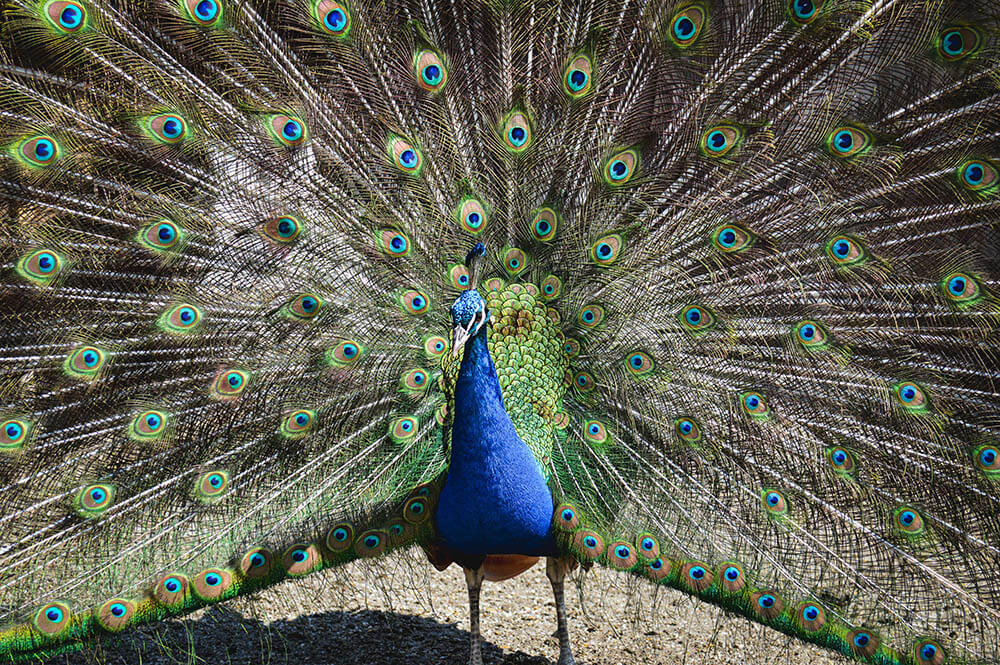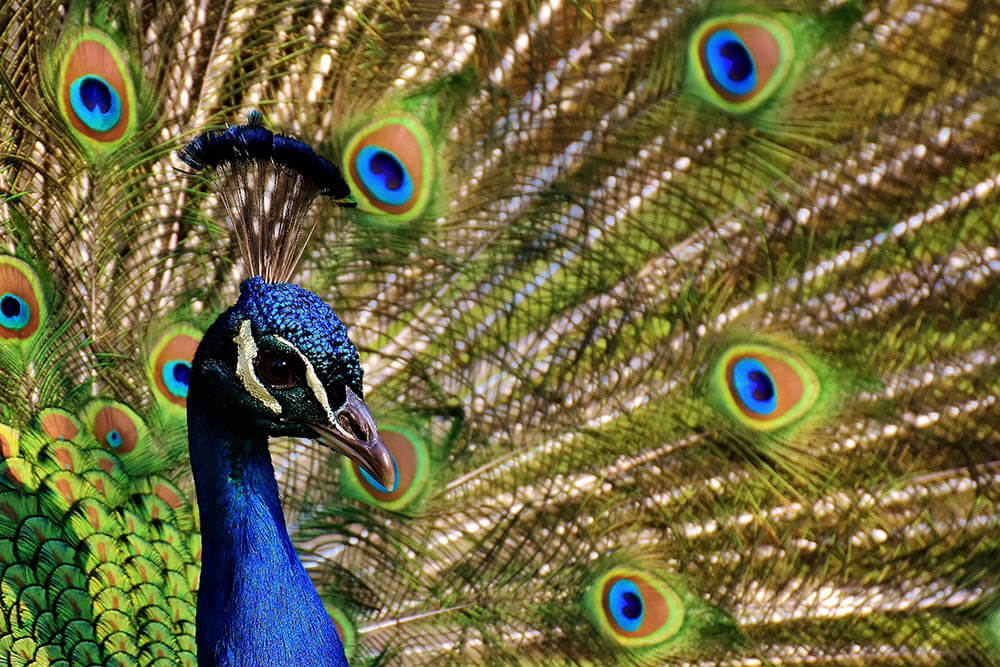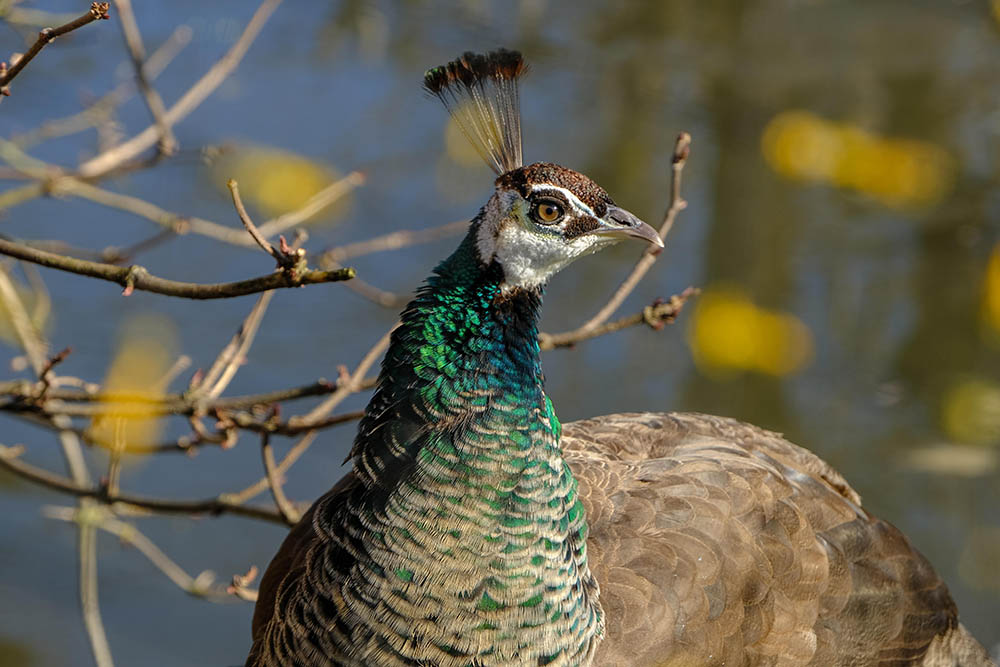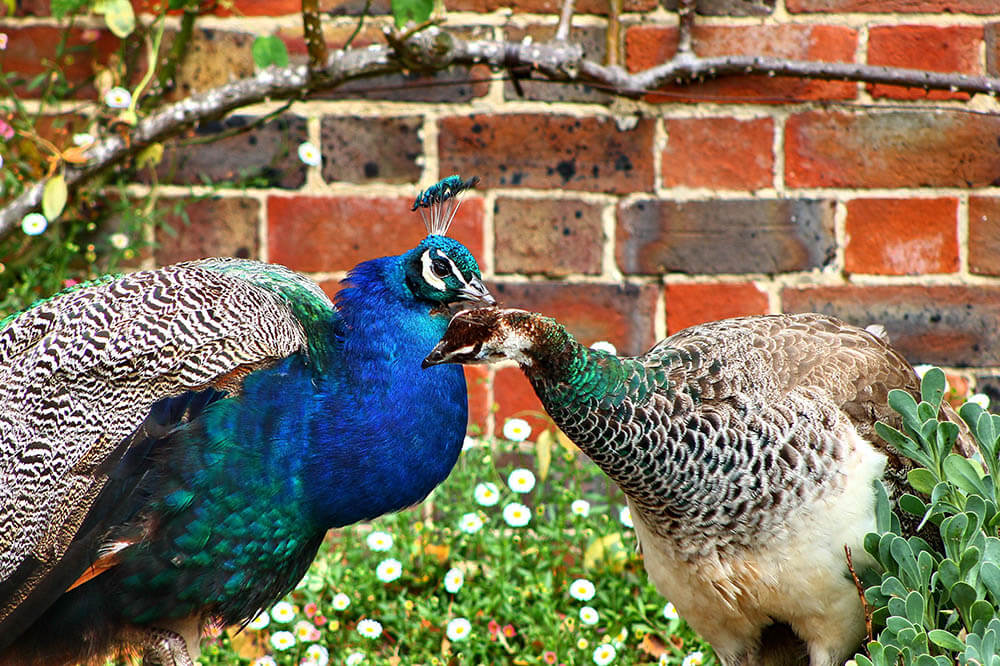Human activity has caused the extinction of many species all over the world. Today, some of the most recognizable animals – including rhinos, elephants, and gorillas – are close to disappearing forever thanks to poaching and the destruction of their habitats.
How about peafowl? Are these amazing birds endangered, or can we breathe a sigh of relief knowing that they’re safe?
We have some good news and some bad news. While some of these birds are thriving, others are marching toward oblivion.
Interested to know more about the peafowl’s conservation status? Then keep reading!
Note: while these birds are popularly known as “peacocks,” the proper, gender-neutral term for the species is “peafowl.” Peacocks are male peafowl, while peahens are female peafowl.

What Is a Peafowl?
Peafowl are large birds with vibrantly colored plumage. They’re particularly famous for the peacock’s iconic courtship behavior, which involves spreading his long, beautiful tail feathers, also known as a “train,” in a wide, fan-like shape. Peacocks do this during the mating season to attract peahens, who select the most impressive males to mate with.
There are three peafowl species, each coming from a different region of the world. Which brings us to…
The 3 Peafowl Species and Their Conservation Status
The three peafowl species are the blue peafowl (Pavo cristatus), the green peafowl (Pavo muticus), and the rarer Congo peafowl (Afropavo congensis).
Blue Peafowl
The blue peafowl, also known as the common peafowl or Indian peafowl, originates from an enormous South Asian region called the Indian subcontinent. Today, their natural habitats include India, Sri Lanka, Pakistan, Bangladesh, Nepal, and Bhutan.
The blue peafowl isn’t endangered – far from it. According to the International Union for Conservation of Nature (IUCN), an international organization that maintains a comprehensive inventory of biological species’ global conservation status, this species is of “Least Concern.” This means its population trend is stable and not at any risk of drastic decline. Said organization discovered this fact after a global assessment back in October of 2016.
While the global population remains to be quantified, the blue peafowl has been observed to be between common and very common locally. Which begs the question…
Why is the blue peafowl doing so well?
In 1963, when the Indian government declared the blue peafowl the country’s national bird, it also prohibited the hunting and eating of this avian species. Furthermore, these creatures are considered sacred throughout their range, and as such aren’t subject to persecution by humans.
For the above reasons, blue peafowl don’t face many threats. In fact, life is so good for these birds that they can settle in many man-made habitats and near towns and villages without any problems. They even explore towns, villages, and cities when looking for food.
The only place where blue peafowl have gone extinct is a territory called Saint Helena, Ascension and Tristan da Cunha – a region that includes Saint Helena Island, Ascension Island, and the Tristan da Cunha archipelago. Humans introduced blue peafowl to these areas, where they’ve since vanished.
We also introduced the blue peafowl to the following regions, where they’re, thankfully, still extant:
- Argentina
- Australia
- Brazil
- Colombia
- Costa Rica
- Croatia
- Guyana
- Honduras
- Indonesia
- Lokrum
- Madagascar
- Mauritius
- Mexico
- New Zealand
- Papua New Guinea
- Portugal
- Réunion
- South Africa
- Spain
- Suriname
- United States of America
- Uruguay
The blue peafowl is the peafowl species that’s most familiar to us, in part thanks to being the most commonly found in zoos.

Green Peafowl
Also known as Indonesian peafowl, green peafowl make their home in Southeast Asia, particularly in the forests of Myanmar (formerly Burma), Laos, Thailand, Vietnam, Cambodia, Indonesia, and Java. They can also be found in China. Sadly, they’re now extinct in India, Malaysia, and Bangladesh.
According to the IUCN, green peafowl have been endangered since 2009.
Back in August 2018, the organization conducted a global assessment of this creature’s conservation status and found that there are only around 10,000 to 19,999 mature green peafowl left in the wild. This means there should be an estimated total of between 15,000 and 30,000 individuals still existing in their natural habitats. IUCN hopes to refine its methods further so that future assessments can produce more accurate results.
Why is the green peafowl doing so poorly?
The utilization and modification of animal habitats are believed to be the major culprit behind this species’ endangerment; in fact, human activity likely hastened declines of more than 50% in green peafowl populations over the last three generations, and their numbers are projected to keep plunging.
The rate of population decline significantly varies across the green peafowl’s range, however.
For example, green peafowl numbers are stable in Myanmar but are restricted to small populations strewn over a hodgepodge of deteriorated habitats. In Thailand, their population is stable and may even be increasing. Recent surveys reveal the species is more widespread in Cambodia than previously thought.
Indonesia saw declines during the 20th century’s first quarter. Though the present trajectory of their population trend remains uncertain, it’s possible their numbers have stabilized.
In Vietnam’s Yok Don National Park, a considerable population decline was observed between 1998 and 2013. Thankfully, Cat Tien National Park saw a rise in green peafowl numbers during the same period, so it’s possible their population here has stabilized or is perhaps even rising.
Severe declines have been noted in a few localities in Laos.
In China, green peafowl have already vanished from 60% of their former habitat. Their remaining numbers are plummeting.
The green peafowl is Myanmar’s national bird.

Congo Peafowl
The Congo peafowl goes by two other names: African peafowl and mbulu, which is what the Bakongo people call it. This Central African species lives in the Democratic Republic of Congo, specifically in the primary and secondary forests of Salonga National Park. It can also be located in Maiko National Park and even in Egypt.
The Congo peafowl isn’t endangered. Nevertheless, the IUCN Red List considers it near-threatened, which means it’s close to being a vulnerable species.
Today, there are only between 2,500 and 9,999 mature individuals in the world. Their total number could therefore be somewhere between 3,500 and 15,000 individuals – a quantity that continues to see a downward trend.
From 2004 to 2005, researchers in Salonga National Park determined a sighting rate of a single Congo peafowl for every 9.03 kilometers.
Why is the Congo peafowl doing so poorly?
Researchers believe habitat loss caused by logging, subsistence agriculture, and mining at various locations contribute to the decline of the Congo peafowl population. Within this species’ range, an 8% loss of tree cover has been estimated across three of its past generations.
Another factor is hunting, which is suspected to account for 10% to 19% of the population decline.
Of the three peafowl species, the Congo peafowl was the most recently discovered in 1936. Today, it is the Democratic Republic of Congo’s national bird.

Marvelous Peafowl Facts
If you’d like to learn more about peafowl, keep reading!
Peafowl are omnivores
Peafowl eat both plant and animal matter. Their diet consists of creatures such as insects, arachnids, worms, reptiles, amphibians, gastropods, and even small mammals such as mice. They also consume fruits, vegetables, and grains.
Peafowl swallow pebbles
Peafowl ingest small stones and store them in a specialized organ called a gizzard, which is found near the digestive system. This organ assists in the grinding of tough plant material.
Peafowl can fly
Despite their long, heavy tail feathers, peafowl are capable of flying short distances. This allows them to perch on tree branches whenever they need to rest at night or escape predators.
Peacocks molt
Once the mating season concludes, a peacock goes through a molting process during which he naturally sheds his tail feathers. Before the next mating season, these feathers grow back, only they’re longer and fuller.
Peacock tail feathers take years to develop
Young peacocks and peahens look identical. A peacock has to wait around three months before his tail feathers start showing some color. And it’s only when a peacock becomes fully mature at three years of age that said tail feathers transform into an exhibition of mesmerizing colors and design.
Peafowl eggs are fairly costly
Some people buy peafowl eggs intending to raise these birds. Others simply want to have those eggs for dinner. Whatever your reason for wanting to buy peafowl eggs, know that it can be fairly costly.
If you plan on making an Indian peafowl omelet, each egg can cost between $10 and $40. If you want to hatch peafowl, prices can range from $20 to over $100.
Peacocks are (generally) polygamous
Peacocks typically don’t settle for one mate, with a dominant male preferring to mate with more than one peahen per mating season. In captivity, however, some green peafowl do form monogamous pairings.

Conclusion
Of the three peafowl species, only the blue peafowl is safe. Its numbers in the Indian subcontinent remain stable thanks to support from the government and religious institutions.
The green peafowl and Congo peafowl aren’t doing too well, with the former nearing extinction and the latter close to becoming vulnerable. What’s even scarier is that their numbers continue to see a downward trend. If humankind keeps destroying their habitats and hunting them, these species may disappear well before the end of the century.
